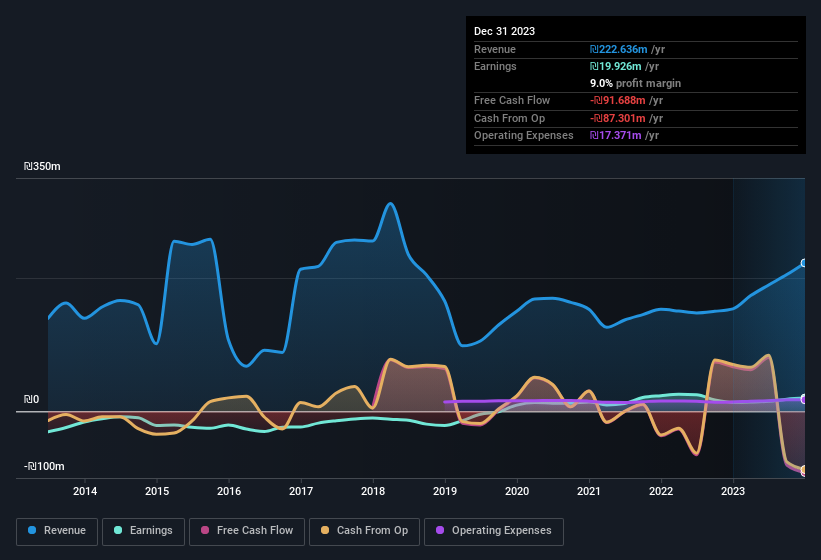Stock Analysis
- Israel
- /
- Real Estate
- /
- TASE:MSLA
Maslavi Construction's (TLV:MSLA) Promising Earnings May Rest On Soft Foundations

Maslavi Construction Company Ltd's (TLV:MSLA) robust earnings report didn't manage to move the market for its stock. We did some digging, and we found some concerning factors in the details.
View our latest analysis for Maslavi Construction

Zooming In On Maslavi Construction's Earnings
One key financial ratio used to measure how well a company converts its profit to free cash flow (FCF) is the accrual ratio. In plain english, this ratio subtracts FCF from net profit, and divides that number by the company's average operating assets over that period. You could think of the accrual ratio from cashflow as the 'non-FCF profit ratio'.
As a result, a negative accrual ratio is a positive for the company, and a positive accrual ratio is a negative. That is not intended to imply we should worry about a positive accrual ratio, but it's worth noting where the accrual ratio is rather high. That's because some academic studies have suggested that high accruals ratios tend to lead to lower profit or less profit growth.
Maslavi Construction has an accrual ratio of 0.39 for the year to December 2023. Statistically speaking, that's a real negative for future earnings. To wit, the company did not generate one whit of free cashflow in that time. Even though it reported a profit of ₪19.9m, a look at free cash flow indicates it actually burnt through ₪92m in the last year. We saw that FCF was ₪67m a year ago though, so Maslavi Construction has at least been able to generate positive FCF in the past. The good news for shareholders is that Maslavi Construction's accrual ratio was much better last year, so this year's poor reading might simply be a case of a short term mismatch between profit and FCF. Shareholders should look for improved cashflow relative to profit in the current year, if that is indeed the case.
Note: we always recommend investors check balance sheet strength. Click here to be taken to our balance sheet analysis of Maslavi Construction.
Our Take On Maslavi Construction's Profit Performance
As we have made quite clear, we're a bit worried that Maslavi Construction didn't back up the last year's profit with free cashflow. For this reason, we think that Maslavi Construction's statutory profits may be a bad guide to its underlying earnings power, and might give investors an overly positive impression of the company. Nonetheless, it's still worth noting that its earnings per share have grown at 37% over the last three years. Of course, we've only just scratched the surface when it comes to analysing its earnings; one could also consider margins, forecast growth, and return on investment, among other factors. If you'd like to know more about Maslavi Construction as a business, it's important to be aware of any risks it's facing. For example, Maslavi Construction has 4 warning signs (and 2 which are a bit concerning) we think you should know about.
Today we've zoomed in on a single data point to better understand the nature of Maslavi Construction's profit. But there is always more to discover if you are capable of focussing your mind on minutiae. Some people consider a high return on equity to be a good sign of a quality business. While it might take a little research on your behalf, you may find this free collection of companies boasting high return on equity, or this list of stocks that insiders are buying to be useful.
Valuation is complex, but we're helping make it simple.
Find out whether Maslavi Construction is potentially over or undervalued by checking out our comprehensive analysis, which includes fair value estimates, risks and warnings, dividends, insider transactions and financial health.
View the Free AnalysisHave feedback on this article? Concerned about the content? Get in touch with us directly. Alternatively, email editorial-team (at) simplywallst.com.
This article by Simply Wall St is general in nature. We provide commentary based on historical data and analyst forecasts only using an unbiased methodology and our articles are not intended to be financial advice. It does not constitute a recommendation to buy or sell any stock, and does not take account of your objectives, or your financial situation. We aim to bring you long-term focused analysis driven by fundamental data. Note that our analysis may not factor in the latest price-sensitive company announcements or qualitative material. Simply Wall St has no position in any stocks mentioned.
About TASE:MSLA
Maslavi Construction
Maslavi Construction Company Ltd operates in the construction and real estate industry in Israel.
Proven track record with adequate balance sheet.

